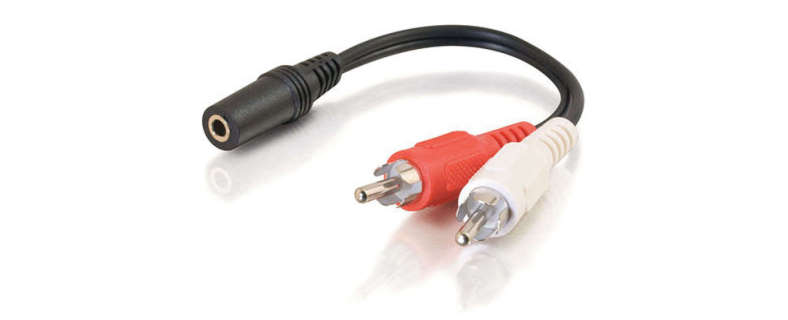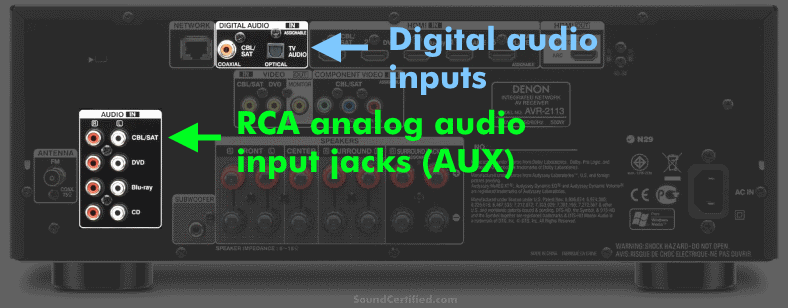Yeah, I know how it feels: lots of TVs out there have terrible speaker sound quality. Or maybe you just want to enjoy better volume with your favorite movies or shows.
In this article, I’ll help you find out if you can connect speakers directly to your TV and what your options are. I hope to help you get the right kind of sound you need and enjoy your television experience!
UPDATE! Due to many reader questions, I’ve added a section about TVs with no adjustable volume output and what you can do in that case.Contents
Can I connect speakers directly to my TV?
Let’s get to the answers to the main question right away.
- Generally speaking, no, you cannot connect speakers directly to a TV. The majority of TVs do not provide speaker outputs that can drive speakers directly as that requires an amplifier of some sort to power them.
- Most TVs do, however, provide audio outputs that allow you to connect them to self-powered (computer) speakers, a small external amplifier, or a home stereo receiver.
- The types of speaker system electronics & cables you need depend on your TV’s output jacks. There’s no standard set of TV audio outputs, although most have RCA (stereo) jacks, a 3.5mm jack, digital optical/coaxial jacks, or something similar.
- For TVs with only an HDMI output jack, it’s still possible to connect an external set of speakers or amp. In that case, you’ll need an HDMI audio extractor that provides RCA output jacks.
So, unfortunately, the bad news is that you can’t hook up speakers directly to a TV (I’ll explain why as we go). However, the good news is you can connect speakers to a TV in other ways – and fairly easily, too!
How TV audio outputs work + the common types
Televisions usually have one or more types of audio outputs: analog (which can be amplified to drive speakers or connect to a home stereo receiver) or digital. Digital signals have to be converted back to analog before they can be used to drive speakers.
The most important thing to know first is that TVs do not offer speaker outputs. Instead, they usually provide analog (and digital, sometimes) low-level outputs to connect to an amplifier, powered speakers, or a home stereo.
Just like with any audio electronics without speaker outputs, the audio signal you can connect to comes directly from the internal electronics from the media you’re enjoying. In this case, the audio is extracted from the TV signal, separated, and copied sent to both the internal speakers (if present) and the audio output jacks.
Analog vs digital TV audio outputs
Analog outputs can be connected to nearly any audio amplifier, powered speakers, or receiver with RCA or similar analog inputs. They’re extremely common – however, not all TVs have them these days.
Digital audio outputs, on the other hand, must be converted to an analog sound signal either using a converter box or can be connected to some home stereo/home theater receivers with digital audio inputs.
The standard digital audio outputs and what they support are:
- Coaxial (RCA jack) digital output: very common for home subwoofer signal output, but can also carry full-range sound too as an alternative to a TOSLINK connector.
- Fiber optic output jack: This is almost always a TOSLINK type connector which uses a plug-in fiber optic cable you can buy (not expensive).
The internal speakers in your TV use an inexpensive audio amplifier chip that supplies enough power to drive with decent, but not great, power & volume.
Common TV analog outputs are:
- RCA stereo jacks: left & right stereo signal outputs, which can be connected to a home receiver’s AUX input RCA or to powered speakers.
- 3.5mm (1/8″) headphone sized stereo jack: left, right, and ground signal connections
Do I need an amp to connect speakers to my TV?
Shown: A basic diagram showing why you need an amplifier to drive speakers with TV sound and how they work.
Yes, you’ll need an amplifier to connect speakers to your TV, either separately or built into powered speakers like computer speakers. A home theater receiver or stereo amplifier with auxiliary audio inputs can also be used.
However, if you don’t already have an amplifier and only have basic needs (like enough power to drive small speakers with ok sound) you don’t have to spend a lot of money.
If you already have a home stereo receiver you can fairly easily take advantage of that. I’ll cover all of these options below.
How to connect speakers to a TV: diagram with examples
You’ve got several basic options when it comes to connecting speakers to your TV, most of which do require spending a little bit of money. However, some ways such as using self-powered PC speakers, are a snap to do in only minutes.
As you can see from my diagram above, there are 4 main ways to get sound by using external TV speakers. These are:
- Using a computer (self-powered) speaker set. This may need a 3.5mm to RCA adapter cable.
- Using a mini amplifier for powering small bookshelf style or other home stereo speakers.
- Connecting the TV sound to a home receiver for using your existing speakers.
- Digital output use: With a digital to analog converter, it’s possible to connect to any stereo receiver, powered speakers, or auxiliary input you like.
1. Using computer speakers
Shown: An example of self-powered computer speakers with 3.5mm audio connection and USB power connector.
Computer speakers are the easiest way to add speakers to your TV. Nearly all come with an audio amplifier built into them and either use an AC-DC adaper or a 5V USB power connection. If your TV doesn’t have a USB power port (most don’t) you can simply use a USB phone adapter.
These speaker types can give great sound quality if you shop carefully and are very affordable, too. A decent pair start close to $15 and above, while there are cheaper products out there. However, the cheaper models tend to have a very “thin” sound: poor treble, poor bass, and overall a very bland sound response.
More advanced speaker sets include a self-powered subwoofer for even better bass response. Since PC speakers use small speaker cones many times they can’t produce much bass without one.
How to connect computer speakers to a TV without a headphone jack
Most PC speaker sets use a standard 1/8″ (3.5mm) stereo headphone connector, so for TVs without a 3.5mm jack you may need an RCA to 3.5mm adapter cable.
They’re usually about $3 or less and available at many online retailers and sometimes your local retail audio/video store, too.
2. Using a small amplifier and separate speakers
Example of a miniature amplifier and bookshelf speakers you can use with a TV for great sound.
You might think that you’ll need to spend a ton of money to power a higher-quality pair of “real” speakers like some great 4 1/2″ or 6 1/2″ just like a regular (and much more expensive) home stereo receiver. It’s not the case at all!
If you shop carefully, it’s possible to use a very basic – and affordable – mini amp and external speakers on a budget. For average TV, movie, and music channel listening you’ll only need 5W or more per channel amp power.
Amplifiers of this kind start in price around $20 with 15W per channel and a great-sounding pair of bookshelf speakers can be found for about $26 and up. Like many things, it depends on your needs and your budget.
As shown in the diagram, you’ll need to connect the amplifier to the TV’s audio outputs using RCA cable or in some cases, and 3.5mm adapter also. Most mini amps come with an AC-DC wall power supply you’ll plug in.
Next, you’ll connect the amp to the speaker terminals using speaker wire and you’re ready.
3. Using a home stereo receiver
Already have a home theater sound system or home stereo receiver? Great news: in nearly all cases they offer at least one auxiliary (“AUX”) input RCA input pair to make it easy to connect your TV for excellent sound.
You’ll just need to connect RCA cables to one of the receiver’s auxiliary inputs. These are sometimes market for TV, cable, and/or DVD or Blu-Ray inputs selected from the main sound control.
On some models, they’re located on the front of the receiver and may be called “AUX” inputs. If your TV doesn’t have analog (RCA or 3.5mm) outputs, the digital inputs can be used. Those are nearly always optical (TOSLINK) or coaxial (RCA style) connectors.
4. Connecting speakers to a TV with digital audio outputs

What if your television only has digital audio outputs? While it is a little bit more complicated, the good news is that you’ll be fine. To use digital audio connections, you’ll need: (1) A stereo receiver with digital audio inputs OR (2) a digital to analog (RCA) converter.
A digital to analog converter is a small box with a wall power input (adapter is supplied) and input & output jacks on both ends. It allows connecting a device with only digital audio out to any standard receiver or amplifier.
Using a digital to analog converter allows you to connect a TV without analog outputs (RCA jacks or a 3.5mm audio jack) to any equipment, making them super handy. Most sell for $15-$25 or so, depending on the brand and seller.
What to do if you can’t adjust your TV’s audio out volume
Examples of 4 workarounds for TVs without an adjustable output volume. Unfortunately, it’s a tough problem but thankfully there are some good ways to deal with it.
Unfortunately, while you can connect speakers or a stereo receiver or amplifier to many TVs, not all TVs allow you to adjust the output volume with your remote. Unfortunately, it’s sort-of “luck of the draw” whether or not your particular model does or doesn’t.
The good news is that there are a few workarounds to help:
- TVs with a digital output: you can use a digital to analog (RCA) converter with remote and adjustable volume output. These cost around $20 USD.
- TVs with only a 3.5mm headphone type or RCA type jacks: you can use a device like the MCM #50-8394 inline volume control with remote, although it’s not as cheap (about $44 USD).
- If you’re on a tight budget or don’t care about a remote control, you can also use inline RCA volume control with knob. You’ll just need connecting cables with enough length.
- Similar to #3, you can also use a 3.5mm headphone type connector inline volume control with an adjustable knob.
Ultimately, it’s up to you what would work best but I’d recommend using the digital audio output and a converter box with a remote if at all possible. That’s not quite as simple as connecting your TV’s audio to a home stereo receiver that already has a remote, but many people don’t have that option.
Several of my readers have mentioned this obstacle and needed a hassle-free way to adjust the sound output of their TV. Sadly, in a lot of cases, the TV manufacturer doesn’t tell you that the audio outputs aren’t adjustable. You may not find out until you actually hook up your speakers and try them out.









